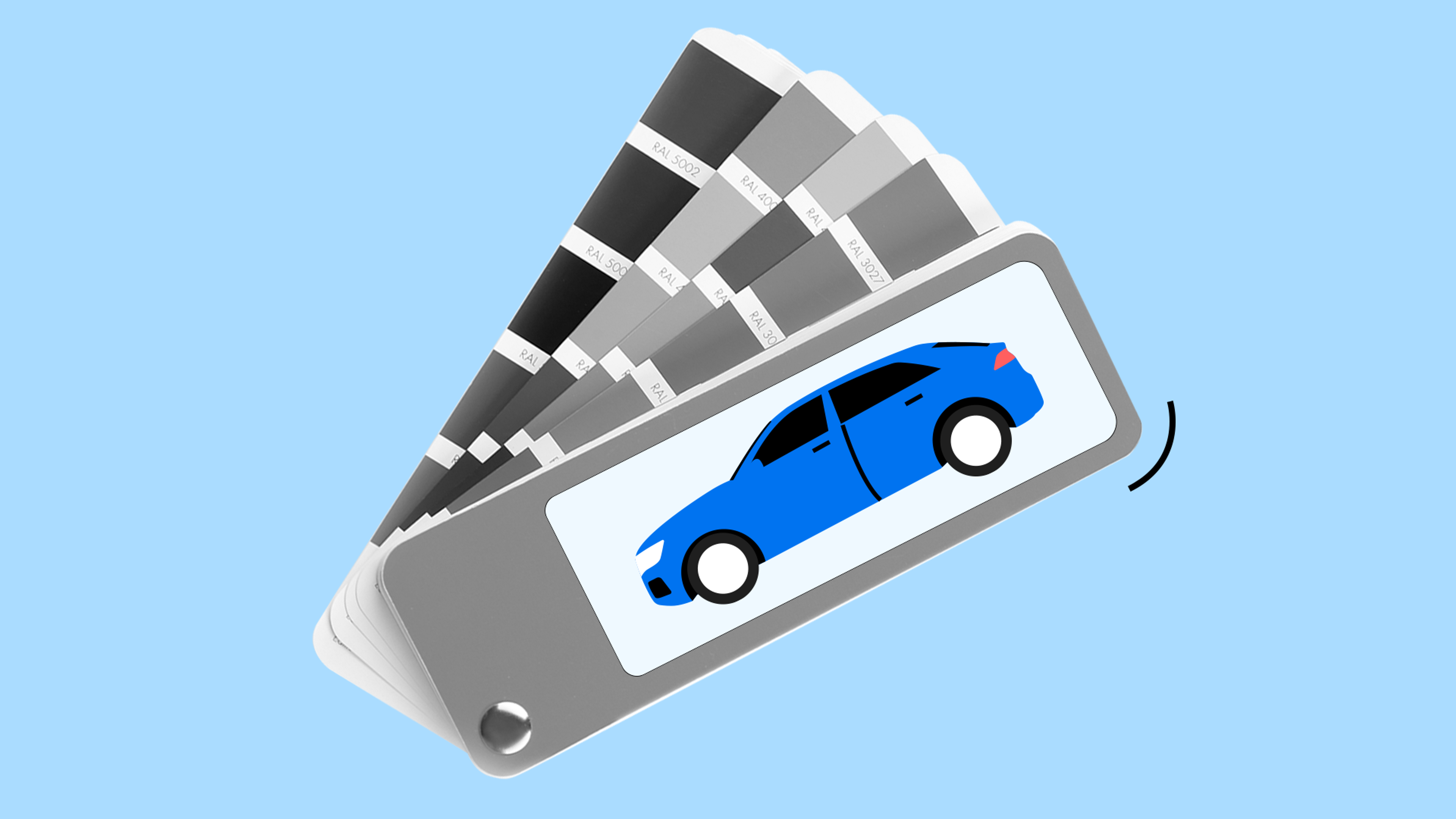10/12/2025
Research: Car colors and why they matter

Most people pick their car color based on taste – a bold red for personality, a sleek black for class, or maybe silver because it “hides dirt better.” But what if your choice of color says more than you think?
We dug into our vehicle history data to uncover what car colors can really tell us about the used car market. Which shades dominate in different countries? How have drivers’ tastes shifted over the years? And can color actually affect how easy to sell a car is?
The results might surprise you – turns out, your car’s color could say a lot about its past, its value, and even its chances of catching a buyer’s eye.
Which car colors are the most popular?
If you look around on the street, you will immediately notice that some car colors are more popular than others. However, vehicle color trends vary from country to country. A color desired in Poland may not be that popular in Portugal or Mexico.
There are more colorful vehicles in countries with warm climates compared to colder countries. You won’t see a bright car in Norway, Canada, or Sweden often, but the situation is quite different in California or Italy.
As a general rule, white cars are more popular in warmer climates, because white reflects sunlight, making these cars less hot to drive.
Our study has revealed that white is the most popular color in Australia (39.1% of the total vehicle fleet) and the EU (26.8%). Australians also adore silver (15.9%) and gray cars (14%). Europeans prefer gray even more (25.9%), followed by black vehicles (24.5%).
A similar percentage of black vehicles can also be found in the US (24.7%). However, they also like white (20.9%) and silver (17.3%) cars.
71% of cars checked on our platform were black, white, gray, or silver. This only proves that people are pretty conservative when it comes to vehicle color.
Have we always loved the same colors?
Vehicle interior and exterior trends have changed significantly throughout the years. And so have the most popular car colors. For instance, 29.9% of cars manufactured in 2000 and checked on the carVertical platform were gray or silver, 18.6% – black, and 18.8% – blue. However, there were not so many white vehicles at that time.
Out of all the cars made in 2024 that were checked, 31% were gray, 29.6% – black, 17% – white, 10.2% – blue, 4% – red, 0.6% – brown, and 0.6% – yellow.
Some colors – like black and gray – stand the test of time better than others, as their share between 2000 and 2024 has remained more or less similar.
While every European country has its own car market quirks, when it comes to color, Europeans are surprisingly alike. Shades of gray, black, and white rule the roads, while bright colors are more of a rare sight. It’s no coincidence – neutral tones are seen as practical, timeless, and a lot easier to keep looking clean.
Still, there’s a reason you don’t see too many fiery reds or sunny yellows in the south for long. Under that Mediterranean sun, bold colors can fade faster than you’d like, leaving older cars with a washed-out look.
But even the classic shades have their downsides. Black cars, for instance, show every smudge, mark, and bird-dropping with dramatic flair – and that can take a toll on the car’s appearance and value.
Gray and white, on the other hand, do a great job of hiding dust, scratches, and minor imperfections – making them the quiet heroes of low-maintenance car colors.
Do car manufacturers prefer specific colors?
A specific color can be a part of a manufacturer’s identity and branding. Red is associated with Ferrari, yellow – with Lamborghini, blue – with Subaru, etc. However, most people are more conservative and manufacturers know that.
Let’s take Audi as an example. Out of all Audis checked on carVertical over a several year span, 37.5% were black, 31.3% – gray, and 10% – white, which represents the current vehicle color trends quite well.
Black is also the most popular selection among BMW customers – 35% and Mercedes-Benz – 36%. Gray is the most popular color in Škoda – 32.75%, Toyota – 34.3%, Volvo – 31%, Opel – 32%, and Volkswagen cars – 33.6%. While it’s possible to purchase a Volkswagen or Mercedes in a bright color, this is a rare choice, and customers prefer time-tested tones.
Some manufacturers like Peugeot or Citroen have introduced bright colors to their palettes throughout the years, which attract younger and more extroverted drivers. However, gray, white, and black are still much more popular among their customers than blue or yellow.
Are some car colors safer than others?
It might sound surprising, but some car colors seem to find trouble more often than others. Now, before you blame the paint, let’s be clear – it’s more correlation than causation. Still, the numbers tell an interesting story.
According to carVertical data, red cars top the list, with 60% of those checked on our platform showing signs of damage. Brown (59%) and black (57%) cars aren’t far behind. On the other hand, yellow (55%) and blue (54%) vehicles tend to have slightly fewer damage records, while white and gray cars (both at 50%) appear to be the safest bets.
Of course, most cars will pick up a few scratches or dents over the years, but statistically speaking, white and gray cars seem to stay out of trouble more often. Then again, this probably says more about who drives these colors – and what kind of cars they’re on – than about the colors themselves.
Interestingly, other research (and a bit of common sense) suggests that brighter cars are actually more visible on the road. Meanwhile, gray and silver cars blend in a bit too well – sometimes even with the asphalt beneath them.
Is it easier to sell some colors?
In short, yes. According to our data, it only takes 7 days on average to sell a green car, making it stand out among other colors. Usually, drivers aiming for less popular colors like green already know what they’re looking for and prioritize a vehicle’s exterior over technical characteristics.
People selling silver and black cars also won’t have to wait long for a buyer, as it takes only 10.4 and 10.8 days respectively to get a bargain on vehicles painted in these colors.
Let’s take the BMW 5 Series as an example, one of the most checked models on carVertical, which can provide valuable insight into this topic. It takes 7.9 days to sell a green 5 Series, 10.9 days – black, and 11.5 days – blue.
Car colors to avoid if you want a quick sale
While yellow cars are rare, owning one may not be the best idea, as you will have problems selling it. According to our study, it takes 17.3 days to sell a yellow car. White (14.6 days) and gray (13.9 days) vehicles are also harder to sell.
Why aren't buyers interested in yellow cars? When it comes to sedans, SUVs, or hatchbacks, yellow is not a common color and drivers prefer more conservative choices. Yellow is mostly used in sports cars and other extravagant vehicles with a very limited circle of buyers.
Let’s analyze the BMW 5 Series even further. Our research indicates that it takes the most time to sell a white 5 Series (14.2 days). BMW drivers love speed and style, suggesting white may not represent their personality traits. A 5 Series in gray (13.9 days) and red (13.7 days) are also not the most popular colors among used car buyers.
It’s also no surprise that some car colors depreciate faster than others. Bold colors, such as yellow, red, and orange hold their value better than white, black, or gray ones. These colors are mostly used in exotic cars that usually depreciate slower.
While picking a car in your favorite color may seem trivial, there’s a whole science behind this simple action. Next time you’re going to look for a used vehicle, make sure you know its peculiar advantages and disadvantages. Otherwise, it may cause you some unforeseen troubles!
Check your VIN
Avoid costly problems by checking a vehicle's history. Get a report instantly!
Methodology
The carVertical study analyzed the vehicle history reports purchased by the company’s customers. Car colors were grouped by production year and ranked by popularity.
